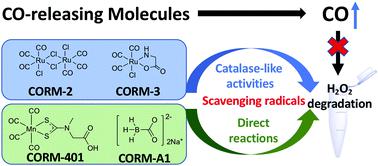当前位置:
X-MOL 学术
›
Chem. Sci.
›
论文详情
Our official English website, www.x-mol.net, welcomes your
feedback! (Note: you will need to create a separate account there.)
Redox and catalase-like activities of four widely used carbon monoxide releasing molecules (CO-RMs)
Chemical Science ( IF 7.6 ) Pub Date : 2021-09-13 , DOI: 10.1039/d1sc03832j Zhengnan Yuan 1 , Xiaoxiao Yang 1 , Binghe Wang 1
Chemical Science ( IF 7.6 ) Pub Date : 2021-09-13 , DOI: 10.1039/d1sc03832j Zhengnan Yuan 1 , Xiaoxiao Yang 1 , Binghe Wang 1
Affiliation

|
The pathophysiological roles of the endogenous signaling molecule, carbon monoxide (CO), have been extensively studied and validated in cell culture and animal models. Further, evidence supporting the therapeutic effects of CO in various human diseases has been mounting over the last two decades. Along this line, there has been intensive interest in developing various delivery forms including CO gas, CO in solution, metal–carbonyl complexes widely known as CO-releasing molecules (CO-RMs), and organic CO prodrugs. Among them, two ruthenium-based carbonyl complexes, CORM-2 and -3, occupy a very special place because they have been used in over 500 published studies. One of the mechanisms for CO's actions is known to be through attenuation of oxidative stress and regulation of production of reactive oxygen species (ROS). For this reason, it is important that CO delivery forms do not have intrinsic chemical redox properties. Herein, we describe our findings of catalase-like activities of CORM-2 and -3 in a CO-independent fashion, leading to the rapid degradation of hydrogen peroxide (H2O2) in PBS buffer (pH = 7.4) and in cell culture media. Further, we have found that CORM-2 and CORM-3 possess potent radical scavenging abilities. We have also studied two other widely used CO donors: CORM-401 and CORM-A1. Both showed chemical reactivity with ROS, but to a lesser degree than CORM-2 and -3. Because of the central role of ROS in some of the proposed mechanisms of actions for CO biology, the discovery of intrinsic chemical redox properties for these CO-RMs means that additional attention in designing proper controls is needed in future biological experiments using these CO-RMs for their CO-donating functions. Further, much more work is needed to understand the true implications of the chemical reactivity of these CO-RMs in cell-culture and animal-model studies of CO biology.
中文翻译:

四种广泛使用的一氧化碳释放分子 (CO-RM) 的氧化还原和过氧化氢酶样活性
内源性信号分子一氧化碳 (CO) 的病理生理作用已在细胞培养和动物模型中得到广泛研究和验证。此外,在过去的二十年里,支持 CO 对各种人类疾病的治疗效果的证据越来越多。沿着这条路线,人们对开发各种递送形式产生了浓厚的兴趣,包括 CO 气体、溶液中的 CO、广泛称为 CO 释放分子 (CO-RM) 的金属-羰基配合物和有机 CO 前药。其中,两种基于钌的羰基配合物 CORM-2 和 -3 占有非常特殊的地位,因为它们已被用于 500 多项已发表的研究。已知 CO 作用的机制之一是通过减弱氧化应激和调节活性氧 (ROS) 的产生。为此原因,重要的是 CO 传递形式不具有固有的化学氧化还原特性。在此,我们描述了我们对 CORM-2 和 -3 的过氧化氢酶样活性的发现,以不依赖于 CO 的方式,导致过氧化氢(H2 O 2 ) 在 PBS 缓冲液 (pH = 7.4) 和细胞培养基中。此外,我们发现 CORM-2 和 CORM-3 具有强大的自由基清除能力。我们还研究了另外两种广泛使用的 CO 供体:CORM-401 和 CORM-A1。两者都显示出与 ROS 的化学反应性,但程度低于 CORM-2 和 -3。由于 ROS 在一些提议的 CO 生物学作用机制中的核心作用,这些 CO-RM 内在化学氧化还原特性的发现意味着在使用这些 CO-RM 的未来生物实验中需要额外注意设计适当的控制因为他们的共同捐赠功能。此外,还需要做更多的工作来了解这些 CO-RM 的化学反应性在 CO 生物学的细胞培养和动物模型研究中的真正含义。
更新日期:2021-09-13
中文翻译:

四种广泛使用的一氧化碳释放分子 (CO-RM) 的氧化还原和过氧化氢酶样活性
内源性信号分子一氧化碳 (CO) 的病理生理作用已在细胞培养和动物模型中得到广泛研究和验证。此外,在过去的二十年里,支持 CO 对各种人类疾病的治疗效果的证据越来越多。沿着这条路线,人们对开发各种递送形式产生了浓厚的兴趣,包括 CO 气体、溶液中的 CO、广泛称为 CO 释放分子 (CO-RM) 的金属-羰基配合物和有机 CO 前药。其中,两种基于钌的羰基配合物 CORM-2 和 -3 占有非常特殊的地位,因为它们已被用于 500 多项已发表的研究。已知 CO 作用的机制之一是通过减弱氧化应激和调节活性氧 (ROS) 的产生。为此原因,重要的是 CO 传递形式不具有固有的化学氧化还原特性。在此,我们描述了我们对 CORM-2 和 -3 的过氧化氢酶样活性的发现,以不依赖于 CO 的方式,导致过氧化氢(H2 O 2 ) 在 PBS 缓冲液 (pH = 7.4) 和细胞培养基中。此外,我们发现 CORM-2 和 CORM-3 具有强大的自由基清除能力。我们还研究了另外两种广泛使用的 CO 供体:CORM-401 和 CORM-A1。两者都显示出与 ROS 的化学反应性,但程度低于 CORM-2 和 -3。由于 ROS 在一些提议的 CO 生物学作用机制中的核心作用,这些 CO-RM 内在化学氧化还原特性的发现意味着在使用这些 CO-RM 的未来生物实验中需要额外注意设计适当的控制因为他们的共同捐赠功能。此外,还需要做更多的工作来了解这些 CO-RM 的化学反应性在 CO 生物学的细胞培养和动物模型研究中的真正含义。











































 京公网安备 11010802027423号
京公网安备 11010802027423号